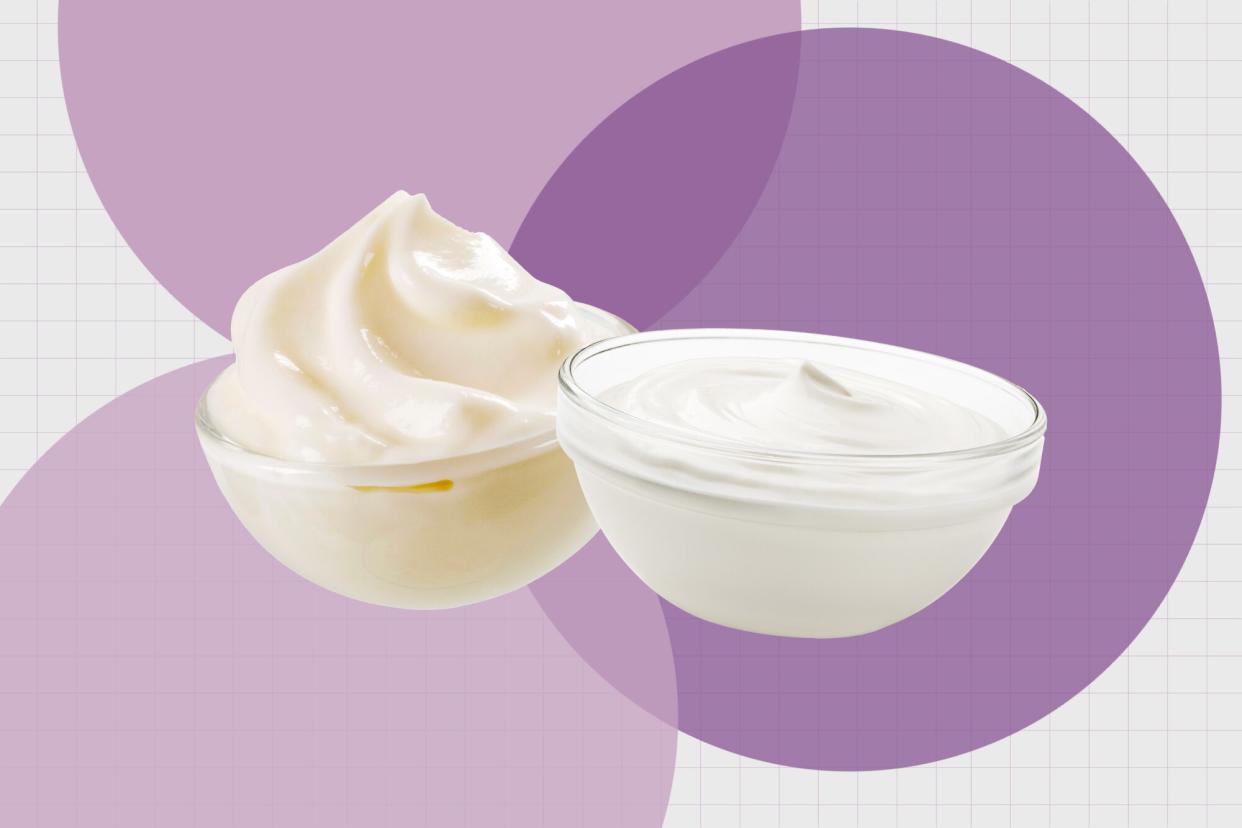Crème Fraîche vs. Sour Cream: What's the Difference?

Getty Images
You're probably familiar with sour cream, which makes frequent appearances as a garnish for your favorite soups and savory dishes. But have you tried créme fraîche? Think of it as the French cousin to sour cream. Here's the rundown on the differences between sour cream and créme fraîche, plus expert insight on how they're both made and what to use them for.
Related: 5 Reasons Cheese Is Actually Good for Your Health
What is crème fraîche?
Crème fraîche, a French specialty, is a cultured cream that can enhance a variety of dishes such as Roasted Chicken Thighs & Radishes with Lemon Crème Fraîche. It is made of cream and bacteria cultures, and can be used as a thickening agent in sauces, in baked goods like our Apple Spice Muffins or atop savory dishes like Black Bean & Chipotle Tostadas with Crème fraîche.
In France, "cream is unpasteurized and therefore contains the bacteria necessary to thicken it naturally," according to The Food Lover's Companion by Herbst and Herbst. "In America, where commercial cream is pasteurized, the fermenting agents necessary for crème fraîche can be obtained by adding buttermilk to sour cream," or by adding lactic acid cultures to sour cream (more on this later).
The flavor of crème fraîche is slightly less tangy than sour cream but the texture tends to be thicker, and the taste overall is richer because it gets about 90% of its calories from fat. Unsurprisingly, crème fraîche is French for "fresh cream." Crème fraîche is phonetically pronounced "krem fresh" in English.
What is sour cream?
Sour cream is made with cream and a lactic acid culture (also present in buttermilk), which thickens and sours the cream. Unlike crème fraîche, sour cream may be thickened with stabilizers like gelatin since it contains less fat. Sour cream gets about 80% of its calories from fat, while light sour cream contains less fat than regular sour cream because it's made with half-and-half instead of cream. Nonfat sour cream is thickened with stabilizers.
What are the main differences?
"The two primary differences between crème fraîche and sour cream are fat content and the culturing process," says Adeline Druart, president of Vermont Creamery. "[Our] Crème fraîche gets its rich, decadent flavor from a proprietary blend of bacterial cultures that are added to fresh cream."
If you're looking to add richness to a hot dish, use crème fraîche instead of sour cream. Since crème fraîche has more fat than sour cream, it will not curdle when simmered or boiled, which can happen to sour cream. But if sour cream is all you have on hand, wait until whatever you're cooking is off the heat before incorporating it. "Sour cream has a lower fat content, leaving it susceptible to breaking at high heat, whereas crème fraîche performs particularly well at a higher heat, say in a sauce, soup or stew, without breaking or separating," says Druart.
When it comes to price, generally, a pint of sour cream will cost you between $2.50 and $3.00, while crème fraîche will set you back between about $4.00 and $8.00 for half as much, 8 ounces.
How are crème fraîche & sour cream made?
Crème fraîche and sour cream are made similarly, by souring raw cream in France, and pasteurized cream in the U.S.
Druart explains how Vermont Creamery's crème fraîche comes together, starting with "fresh Vermont cream, which is received at the creamery in Websterville, Vermont. After pasteurization of the cream, a blend of bacterial cultures are added, and allowed to culture overnight for up to 20 hours, until the unique, rich and nutty flavors develop. It is then packaged in 8-ounce cups."
As for sour cream, Druart says it is "generally made with pasteurized cream, then milk solid is added along with starter cultures. Once the cream thickens, the product is packaged in cups."
Can I make my own at home?
Yes, sour cream and crème fraîche can be made at home with just two ingredients each. For crème fraîche, combine a cup of cream with 2 tablespoons buttermilk in a glass container (or other nonreactive vessel), and let stand at room temperature for 8 to 24 hours. For sour cream, double the amount of buttermilk, and let stand 24 to 48 hours. Refrigerate both for 24 hours before use.
Are they interchangeable?
If you can't find crème fraîche at your local grocery store, sour cream can be used as a 1:1 substitute, and vice versa. Just keep in mind that sour cream is a bit more sour in flavor and less rich than crème fraîche.
"Crème fraîche can substitute in any recipe that calls for sour cream," suggests Druart. "We like it in mashed potatoes, on top of a pie or tart, baked into a cake, or used to make frosting."
What can I use instead of crème fraîche & sour cream?
If you can't get a hold of crème fraîche or sour cream, try using mascarpone or full-fat Greek-style yogurt instead. Mascarpone is a versatile Italian cream cheese from the country's Lombardy region in the north, similar in texture and taste to crème fraîche. Greek yogurt can be made quickly at home with just two ingredients, too, but isn't as rich as crème fraîche.
Bottom Line
Crème fraîche and sour cream have some differences, but can be used as substitutes for each other in most cases. Just remember to turn off the heat before mixing sour cream into whatever creamy dish you're cooking for dinner. Both can be made easily at home if you aren't able to find them in store, and can add a touch of creaminess and tang to savory Smashed Brussels Sprouts or garnish sweet Chocolate Hazelnut Tarts.

